How to prune hydrangeas in the fall
Hydrangeas are gorgeous flowers that will always attract attention with their splendor and delicate shades. And in order for them to proudly and dignifiedly hold themselves in the personal plot, it is necessary to properly put your hands on their pruning in the fall.
This article is devoted to why and when to prune plants, as well as the features and rules for pruning various varieties of a wonderful flower.

Content
Why you need to prune hydrangeas
Hydrangea pruning is primarily carried out in order to ensure that the shrub blooms magnificently and the inflorescences are large.If this is not done, then the bush will be very thickened and there will be many small flowers.
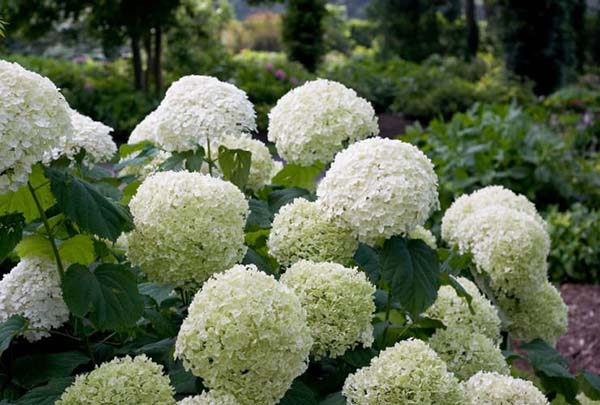
Also trimming is done for the purpose of shaping, i.e. you can form a bush in the shape you want. In this case, you will need to mostly remove only inflorescences and grow powerful, thick shoots, or 1 stem.
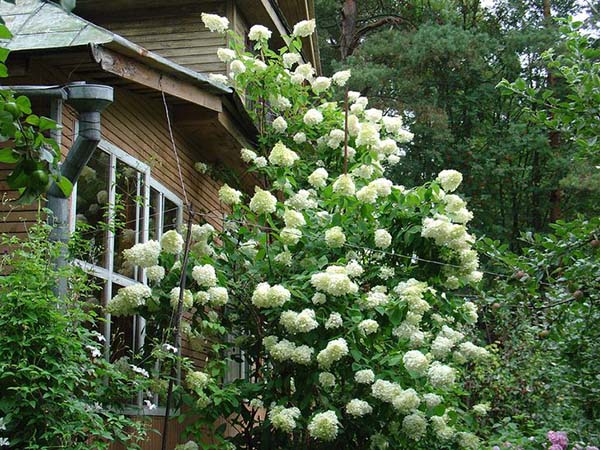
Important! Pruning hydrangeas up to 2-3 years old is not done at all.
But already from 2-3 years of life, the shrub begins to be cut and shaped.
When to prune hydrangeas in the fall: optimal timing
It is very convenient to cut panicle and tree hydrangeas in late autumn, when the first frosts pass (even after the first snow), respectively, all the leaves will fly around, and only one dry bronze inflorescences will remain. At this time, it is easy to understand which shoots should be left and which should be cut.
Thus, the approximate timing of pruning hydrangeas in the fall in the middle lane (Moscow region) is the second half of October - early November.
Actual question! Can a hydrangea be cut when it is still white (pink, blue) and covered in leaves?
Yes, you can, but not too early, otherwise re-growth from lateral shoots may occur and this will weaken the bush before wintering.
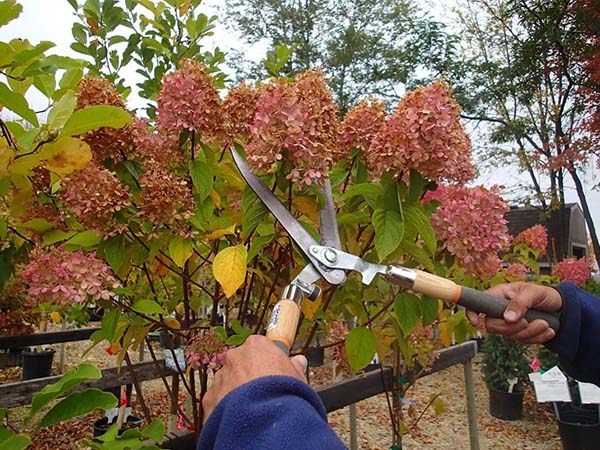
Features of autumn pruning
If you have snowy winters, then fall is recommended. prune hydrangeas that have very large inflorescences (these are precisely certain varieties of tree and paniculate), because under the weight of snow they can tilt and break. Therefore, it is better to cut them in the fall. Moreover, you can only cut the flowers themselves (balls), and shorten the stems to the desired height in the spring.

However, the main advantage of completely pruning hydrangeas in the fall is precisely the fact that in early spring it can be difficult to catch up to the moment when the plant wakes up and starts growing (it starts an active vegetation), which means that the cuts may start to "cry" (from - why the flower may eventually weaken and not bloom).
By the way! If you did a full pruning in the fall, then in the spring it will still not be superfluous to carry out sanitary pruning, removing all extinct and broken branches.
When is it possible and / or better to prune - in autumn or spring
Paniculate and treelike hydrangeas can be pruned both in autumn and spring, or pruned in several stages (cut off some in the fall, and finish what has begun in spring). But the large-leaved one is cut only in the spring. Pruning of young bushes 2-3 years old (which still have thin stems) is most often also left in the spring.
Note! Main advantage spring pruning in the fact that in the spring you can see which buds are preserved. Therefore, in the fall, they are usually pruned higher, leaving at least 3-4 pairs of buds.
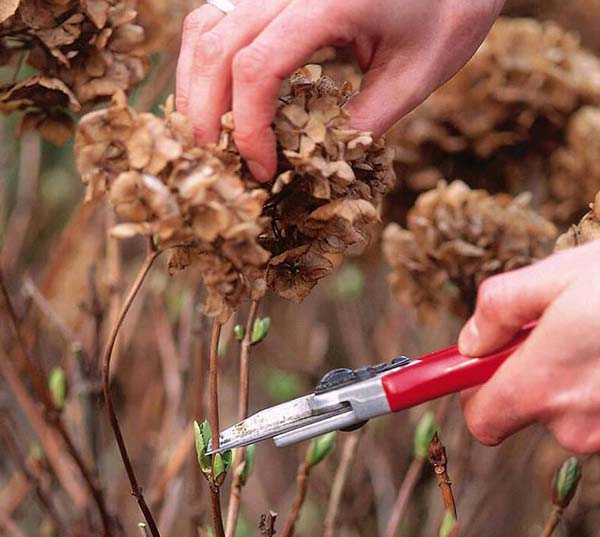
How to prune hydrangeas: basic nuances and rules
There are 3 types of hydrangeas that are most commonly grown in our gardens:
- Paniculate (elongated inflorescences, similar to panicles).
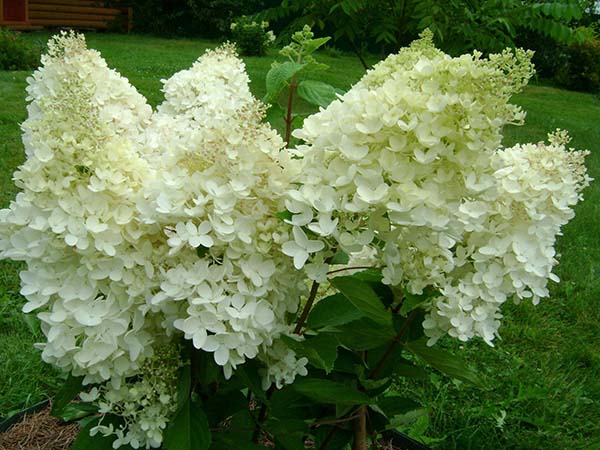
By the way! In some varieties of panicle hydrangea, white panicle inflorescences turn pink by autumn.
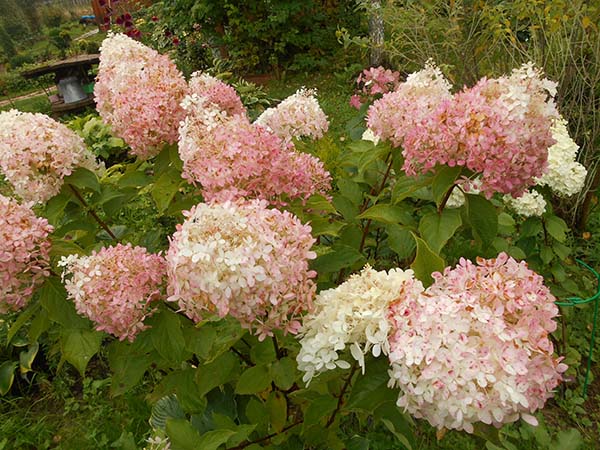
- Arboreal (inflorescences are flatter and rounded, rather large in size, similar to balls).
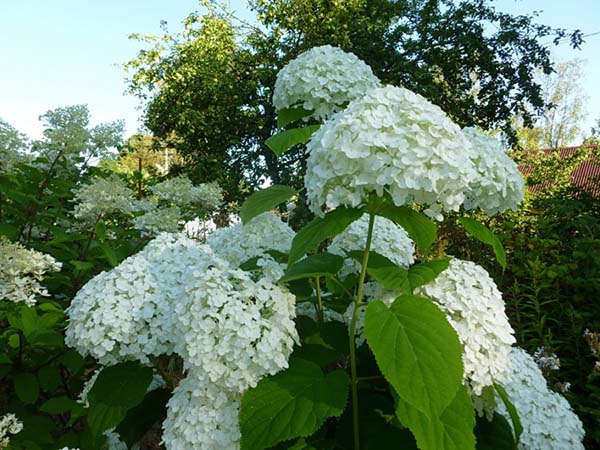
By the way!In some varieties of tree hydrangea, the balls also begin to turn green or pink towards autumn, and there are even pink varieties.
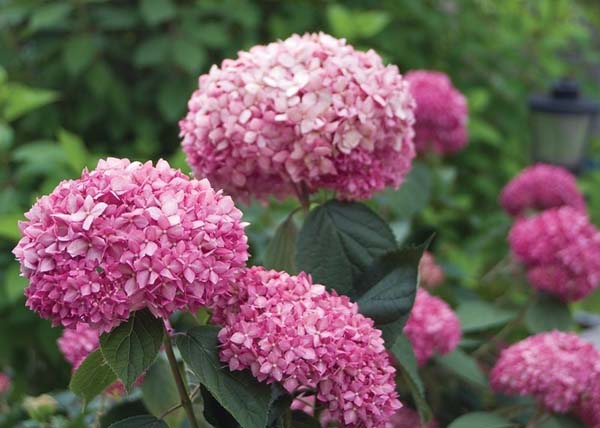
- Large-leaved or colored (inflorescences are similar to tree-like "balls", but it has denser leaves to the touch).
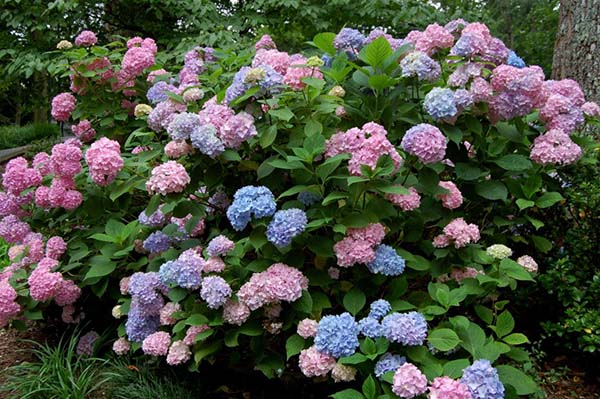
Note! It is fundamentally important to know the type of hydrangea growing in your summer cottage, since it is the type that determines the specifics of pruning and the need for shelter for the winter.
What are the differences between different types of hydrangea:
- Paniculata and treelike hydrangeas (also called white)bloom on the shoots of the current year. Shelter for the winter is not required.
- And at large-leaved (color) -inflorescences are laid on the shoots of the last year. Accordingly, it requires a completely different pruning, in other words, by making a standard pruning, we can simply deprive ourselves of flowering next year. For the winter, be sure to take cover.
Interesting! Tree hydrangea grows as a bush (contrary to its name), and panicle hydrangea, usually, has only 3-4 shoots or generally only 1 stem... Moreover, from 3-4 shoots, you can also form a hydrangea in a standard form. Only the bottom will not have one trunk, but 3-4 stems.
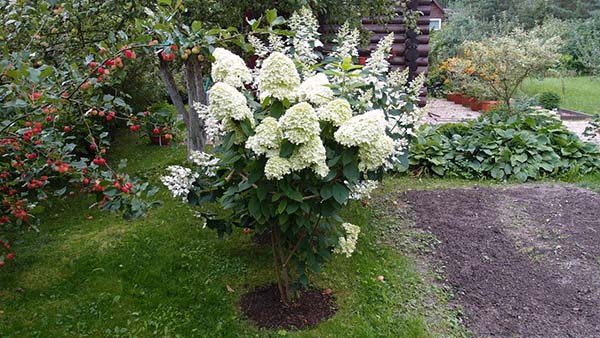
Video: difference in species and methods of pruning hydrangeas
Next, the features of autumn pruning of paniculate, tree-like and large-leaved varieties will be described in detail.
Pruning panicle hydrangea in autumn
As a rule, in the fall, only faded inflorescences are cut off in paniculate hydrangea (1), and in the spring they carry out a complete (final) pruning (2,3,4,5), that is, pruning is carried out in 2 stages, namely:
- Removal of cone-shaped inflorescences (those same "panicles").

- Pruning broken, dead branches (sanitary pruning).
- Removing old (perennial) branches with dying growth (rejuvenating pruning).
- Shortening shoots for the growth of larger young inflorescences (pruning for flowering).
- Removal of excess shoots (for example, growing inside the bush or weak) in order to avoid thickening and shading of the shrub (thinning pruning).
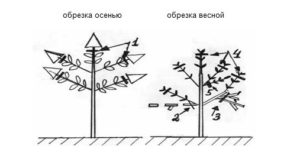
Important! However, it is believed that in autumn, you can carry out a complete pruning of panicle hydrangeabut leaving some margin. For example, when pruning for flowering (5), 3-4 pairs of strong buds should be left.
It is worth understandingthan less buds are left, the more powerful the shoots and inflorescences will be, the more - the thicker the bush, and the smaller the inflorescences.
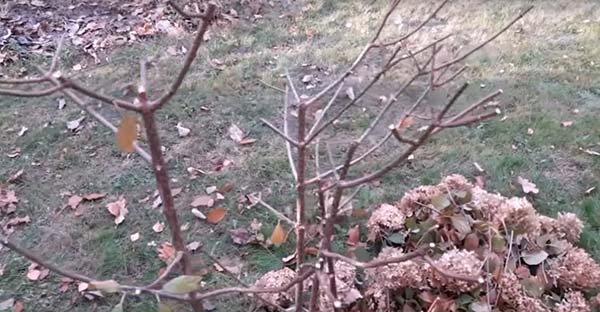
Video: pruning panicle hydrangea in the fall (formative pruning)
Actual question! How to form a panicle hydrangea?
First, you need to let the shoots grow upward, removing only the lateral processes, and this should be done in the spring. Then cut it in height and form the crown.
By the way! Forming into one stem is quite dangerous - either you can accidentally break it, or strong winds. Although, if you tie it to a peg, you can.
Pruning tree hydrangea in autumn
Video: what is the difference between pruning tree and panicle hydrangeas
Thus, in the fall, only faded inflorescences (1) are cut off from a tree hydrangea, and in the spring a complete (final) pruning is carried out (2,3,4,5), namely:
- Removal of faded globular inflorescences.
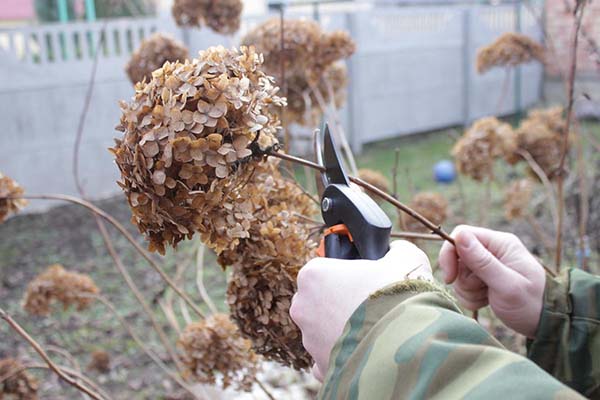
- Pruning broken ends of branches into 3-4 pairs of buds, as well as removing dried shoots (sanitary pruning).
- If the bush is old, then complete ("zero") removal of old (more than 4 years old) branches is performed, especially if they have weak and thin shoots (rejuvenating pruning).
- Removing "under zero" all thin zero shoots (coming from the ground) that did not bloom. The next year, only leaves are still formed on them, thus they will thicken the bush and take food from it. And all new weak growths growing inside the bush and thickening it (thinning pruning).
- Pruning current shoots on old branches and all zero shoots by 2-3 pairs of strong buds (pruning for flowering).
Idea! You can make winter bouquets from tree hydrangea by cutting off a long shoot and painting the brown caps with a spray can (ideally with golden floral paint).
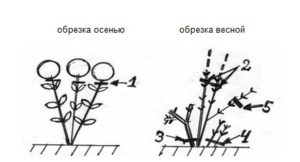
Important! It is also believed that in autumn, you can carry out a complete pruning of the tree hydrangea, again leaving some margin. For example, when pruning for flowering (5), 3-4 pairs of strong buds should be left.
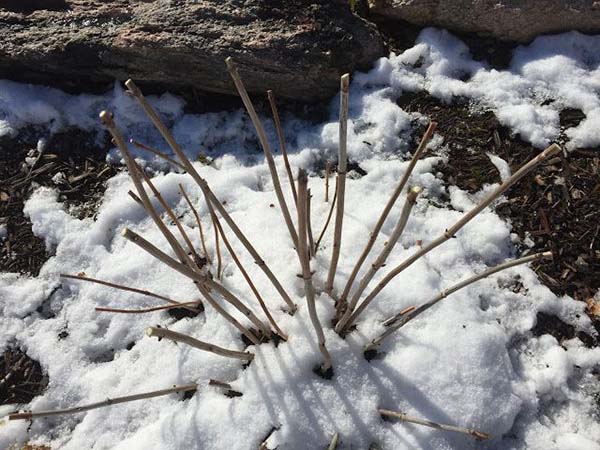
Video: pruning a tree hydrangea in the fall (full)
By the way! In general, tree hydrangea, when pruning anti-aging, can be cut very shortly, 15-20 cm from the ground, and at the same time leave at least 1 pair of buds. But it is worth understanding that if they persist, then the new side shoots will bloom vigorously, and if not, then only "zero" shoots from the root will go, which may not bloom next year.

Pruning large-leaved hydrangea in autumn
The classic scheme for the phased pruning of large-leaved hydrangea in autumn and spring looks like this:
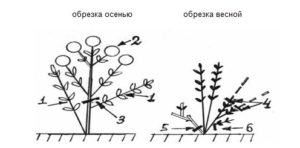
Autumn:
- New (young) shoots are preserved that have not yet bloomed (large-leaved blooms on last year's shoots).
- Biennial faded branches should be removed.
- Moreover, pruning of two-year-old faded branches (2) is carried out up to the outgoing new (young) branch, which did not bloom this year (1).
Think! Many growers prefer not to touch the large-leaved hydrangea at all in the fall, but to do everything in the spring.
But still in the fall, you can cut off the inflorescences and remove the leaves (except for the apical ones).
Moreover, it is recommended to cut the inflorescences to the first pair of buds at the end of the twig, that is, they (the buds) should never be touched. In addition, a stem of about 1.5-2 cm (long stump) should be left above them.
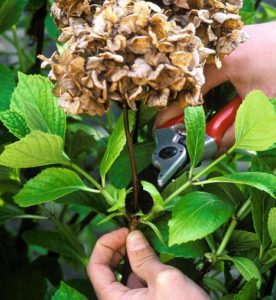
In the spring:
- 4. Dead, frozen, damaged branches are pruned (sanitary pruning).
- 5. Perennial branches are cut out, in which the development of young shoots has noticeably faded (rejuvenating pruning).
- 6. Weak and densely growing shoots are pruned and cut (thinning pruning).
Note! Now, remontant varieties of large-leaved hydrangeas (Eternal Summer, You & Me, Forever & Ever), which also bloom on the shoots of this year (and last ), which means that pruning them will be similar to the procedure for paniculate and tree species.
Video: autumn pruning of a remontant large-leaved hydrangea blooming on the shoots of the current year
Autumn pruning of hydrangea will help to enhance the growth and abundant blooming of inflorescences, to create a new shape of the bush. You already know how to do it right. So everything will turn out great!
Video: how to properly prune hydrangeas in the fall


Thanks for the article, I learned a lot about hydrangea and its features